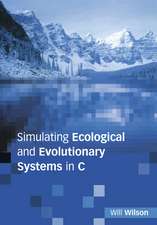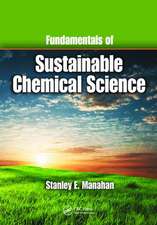Principles of Environmental Engineering
Editat de Yan Liu, Liang Lien Limba Engleză Hardback – 17 ian 2024
Preț: 658.88 lei
Preț vechi: 775.14 lei
-15% Nou
Puncte Express: 988
Preț estimativ în valută:
126.07€ • 131.99$ • 104.32£
126.07€ • 131.99$ • 104.32£
Carte tipărită la comandă
Livrare economică 07-21 aprilie
Preluare comenzi: 021 569.72.76
Specificații
ISBN-13: 9789811694301
ISBN-10: 9811694303
Pagini: 528
Ilustrații: XII, 528 p. 208 illus., 7 illus. in color.
Dimensiuni: 155 x 235 mm
Greutate: 0.93 kg
Ediția:1st ed. 2023
Editura: Springer Nature Singapore
Colecția Springer
Locul publicării:Singapore, Singapore
ISBN-10: 9811694303
Pagini: 528
Ilustrații: XII, 528 p. 208 illus., 7 illus. in color.
Dimensiuni: 155 x 235 mm
Greutate: 0.93 kg
Ediția:1st ed. 2023
Editura: Springer Nature Singapore
Colecția Springer
Locul publicării:Singapore, Singapore
Cuprins
Prolegomenon.- Fluid Flow and Transport Equipment.- Heat Transfer.- Absorption.- Chemical and Biological Reaction Kinetics and Reactor.- Appendix.- Basic Concepts and Terminology.- Symbols and Units.
Notă biografică
Prof. Yan LIU has conducted research, consulting and teaching in environmental engineering in Shanghai and Hong Kong after she obtained her BSc, MPhil and PhD degrees at Tongji University, Shanghai, P. R., China, during 1980 to 1990. She has been a full professor in the Department of Environmental Science and Engineering, Fudan University, Shanghai, China, from 2005. She has published over 160 journal articles including those published in Water Research, Environmental Science and Technology, Nature: Scientific Reports, Biotechnology and Bioengineering, Critical Reviews in Environmental Science and Technology, Journal of Hazardous Materials, etc., held 24 China patents and completed 32 research projects from foundation, 40 consulting research and 11 design projects. Her research interests include drinking water treatment, drinking water disinfection health risk control, mechanism of biological denitrification and phosphorus removal, intracellular polymer synthesis and transformationmechanism of sewage, formation mechanism of extracellular polymers and role in the sewage treatment, anaerobic biological treatment for municipal wastewater at ambient temperature, urban drainage system, urban non-point source pollution control, urban water network system, wastewater recycling, toxic and harmful organic matter removal by anaerobic biological treatment, etc., as well as many research achievements have been made and applied in the treatment of industrial wastewater including pesticide, pharmaceutical, coking, printing and dyeing, chemical, casting, etc.. She has been teaching undergraduates and postgraduates for master's or doctoral degree including principles of environmental engineering, water pollution control, industrial water pollution control, water treatment, industrial wastewater treatment, chemistry of water treatment, theory and design for wastewater treatment, environmental microbiology, wastewater treatment experiment, environmental monitor and analysis, etc.since 1990. She has trained 27 postgraduate students for getting their master degree and 8 for PhD and was awarded as outstanding postgraduate tutor of Fudan University in 2011.
In 2011, Liang LI joined the School of Environmental and Architecture in University of Shanghai for Science and Technology. During 2011–2020, he was awarded the projects of National Natural Foundation of China, Key projects of basic research of Shanghai Science and Technology Commission, Chenguang project of Shanghai Education Commission, etc. In 2015, he was promoted to an associate professor. More than 30 academic papers have been published.
In 2011, Liang LI joined the School of Environmental and Architecture in University of Shanghai for Science and Technology. During 2011–2020, he was awarded the projects of National Natural Foundation of China, Key projects of basic research of Shanghai Science and Technology Commission, Chenguang project of Shanghai Education Commission, etc. In 2015, he was promoted to an associate professor. More than 30 academic papers have been published.
Textul de pe ultima copertă
This textbook contains the contents coming from hydraulics, hydrodynamics, chemical principles, chemical reaction engineering and bioengineering, which relates closely with fundamental principles in environmental engineering. It mainly covers principles including basic concepts, theories, methods and related equipment in fluid flow and transportation, heat transfer, absorption, chemical and biological reaction kinetics and reactors, as well as their applications in environmental engineering. At same time, the readers learns the basic viewpoints and methods commonly used in engineering technology, such as balance method, reasonable simplification, dimensional analysis method, boundary layer theory, optimization and mathematical model method. It broadens the student’s understanding in solving those problems in environmental engineering, and enhances their awareness of industrialization. This book is the specialized foundation and principles for learning the professional courses of environmental engineering, such as "water pollution control," "air pollution control," "solid waste treatment and disposal" and "ecological restoration engineering", while avoiding the repetition of the contents of those professional books.
Caracteristici
Covers essential content from hydraulics, hydrodynamics, chemical principles, chemical reaction Provides a complete and comprehensive fundamental knowledge system for Offers basic knowledge for further learning on professional courses





















